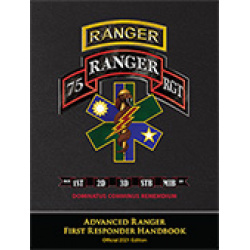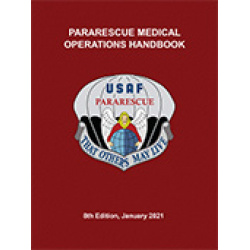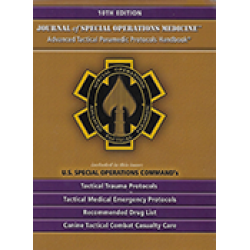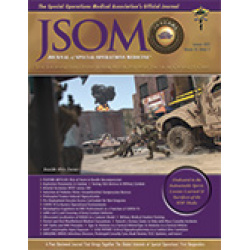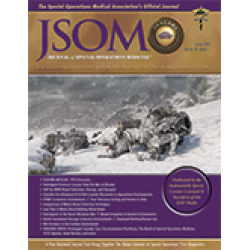Breakaway Media, LLC

For orders of 5 or more, click here to fill out the Request Form, and we will contact you with a quote.
Digital Flipbook and PDF versions of this handbook are available as a subscription to the JSOM. You can subscribe here.
View the Table of Contents
Customers living in Europe can purchase the Advanced Ranger First Responder Handbook 2021 Updates through WERO GmbH and save a significant amount of money on shipping and processing. The ARFR can be purchased at this link.
Before you buy, you will receive an offer with your total price, including shipping and VAT.
Kunden mit Wohnsitz in Europa können die Advanced Ranger First Responder Handbook 2021 Updates über die WERO GmbH erwerben und dabei erheblich an Versand- und Bearbeitungskosten sparen. Die ARFR kann unter diesem Link erworben werden.
Vor dem Kauf erhalten Sie ein Angebot mit Ihrem Gesamtpreis, inklusive Versand und Mehrwertsteuer.
This revised handbook includes an outline of the principles of PJ medicine and the patient assessment checklist. This approach to patients is slightly modified from traditional primary and secondary surveys to reflect a more efficient and comprehensive approach to combat trauma based on PJ experience and data from Overseas Contingency Operations.
This handbook includes portions of the Tactical Combat Casualty Care (TCCC) guidelines and the ATP Tactical Medical Emergency Protocols (TMEPS) pertaining to Pararescue. These protocols have are to suit the PJ mission. The goal remains to have all PJs work to a single standard. The section on prolonged care has been modified and expanded based on PJ experiences.
For orders of 5 or more, click here to fill out the Request Form, and we will contact you with a quote.
Digital Flipbook and PDF versions of this handbook are available as a subscription to the JSOM. You can subscribe here.
View the Table of Contents.
This version of the PJ Handbook is printed on waterproof, tearproof paper and is spiral bound with a 1/2" ring.
For orders of 5 or more, click here to fill out the Request Form, and we will contact you with a quote.
Digital Flipbook and PDF versions of this handbook are available as a subscription to the JSOM. You can subscribe here.
View the Table of Contents
Print: 978-1-7366242-3-4
Customers living in Europe can purchase the Ranger Medic Handbook 2022 Updates through WERO GmbH and save significant money on shipping and processing. The RMH can be purchased at this link.
Before you buy, you will receive an offer with your total price, including shipping and VAT.
Kunden, die in Europa leben, können die Ranger Medic Handbook 2022 Updates über die WERO GmbH erwerben und dabei erheblich an Versand- und Bearbeitungskosten sparen. Das RMH kann unter diesem Link erworben werden.
Vor dem Kauf erhalten Sie ein Angebot mit Ihrem Gesamtpreis, inklusive Versand und Mehrwertsteuer.
The Advanced Tactical Protocols-Paramedic (ATP-P) Handbook is an essential reference tool for tactical and combat medics, SWAT team members, and medical professionals operating in austere environments.
This handbook is printed on waterproof/tearproof paper. Please note: Do not expose this product to chemicals such as cleaning supplies, lotions, etc., as your book will be damaged.
This revision contains updates to the Airway Management protocols, Respiration / Breathing in Tactical Field Care, and K9 TCCC protocols.
Digital Flipbook and PDF versions of this handbook are available as a subscription to the JSOM. You can subscribe here.
The Advanced Tactical Protocols-Paramedic (ATP-P) Handbook is an essential reference tool for tactical and combat medics, SWAT team members, and medical professionals operating in austere environments.
This handbook is printed on standard paper and is NOT waterproof or tearproof.
This handbook is printed on the same standard paper as the ATP-10th edition. We also offer this handbook in waterproof/tearproof paper.
For orders of 5 or more, click here to fill out the Request Form, and we will contact you with a quote.
Digital Flipbook and PDF versions of this handbook are available as a subscription to the JSOM. You can subscribe here.
Brandt M, Liccardi C, Heidle J, Woods TD, White C, Mullins JR, Blackwell J, Le L, Brantley K 23(2). 44 (Journal Article)
Background: Recent data published by the Special Operations community suggest the Lethal Triad of Trauma should be changed to the Lethal Diamond, to include coagulopathy, acidosis, hypothermia, and hypocalcemia. The purpose of this study is to determine the prevalence of trauma-induced hypocalcemia in level I and II trauma patients. Methods: This is a retrospective cohort study conducted at a level I trauma center and Special Operations Combat Medic (SOCM) training site. Adult patients were identified via trauma services registry from September 2021 to April 2022. Patients who received blood products prior to emergency department (ED) arrival were excluded from the study. Ionized calcium levels were utilized in this study. Results: Of the 408 patients screened, 370 were included in the final analysis of this cohort. Hypocalcemia was noted in 189 (51%) patients, with severe hypocalcemia identified in two (<1%) patients. Thirty-two (11.2%) patients had elevated international normalized ratio (INR), 34 (23%) patients had pH <7.36, 21 (8%) patients had elevated lactic acid, and 9 (2.5%) patients had a temperature of <35°C. Conclusion: Hypocalcemia was prevalent in half of the trauma patients in this cohort. The administration of a calcium supplement empirically in trauma patients from the prehospital environment and prior to blood transfusion is not recommended until further data prove it beneficial.
Powell E, Betzold R, Kundi R, Anderson D, Haase D, Keville M, Galvagno S 24(1). 32 (Journal Article)
Background: Veno-venous extracorporeal membrane oxygenation (VV ECMO) is a low-frequency, high-intensity procedure used for severe lung illness or injury to facilitate rapid correction of hypoxemia and respiratory acidosis. This technology is more portable and extracorporeal support is more frequently performed outside of the hospital. Future conflicts may require prolonged causality care and more specialized critical care capabilities including VV ECMO to improve patient outcomes. We used an expert consensus survey based on a developed bifemoral VV ECMO cannulation checklist with an operational focus to establish a standard for training, validation testing, and sustainment. Methods: A 36-item procedural checklist was provided to 14 experts from multiple specialties. Using the modified Delphi method, the checklist was serially modified based on expert feedback. Results: Three rounds of the study were performed, resulting in a final 32-item checklist. Each item on the checklist received at least 70% expert agreement on its inclusion in the final checklist. Conclusion: A procedural performance checklist was created for bifemoral VV ECMO using the modified Delphi method. This is an objective tool to assist procedural training and validation for medical providers performing VV ECMO in austere environments.
Hetzler MR, Fogarty JA, Frament C 24(1). 95 (Journal Article)
This paper is designed to introduce, propose, inform, and advocate enhanced relationships between the medical communities of special operations and space. Although each provides service support in different roles and functions, similarities in both the operational context and in medical care are notable. During a recent interaction, significant relationship potential was discovered by both communities, and recommendations for greater engagement are proposed herein. By identifying and appreciating similarities and understanding history, key actors, and authorities to analyze and realize opportunities will enable us to find synergy for the development of like efforts and goals. Collaboration in research on the limits of human performance and medical support to the most austere and challenging operational environments may benefit both communities in different but productive ways. Establishing and increasing cooperation will also meet command strategic intent, explore and advance a policy concept, initiate a relationship between unique medical communities, and provide a tangible success for the advancement of operational support.
Jeschke EA, Wyma-Bradley J, Baker JB, Dorsch J, Huffman SL 24(1). 90 (Journal Article)
Building upon our strategic framework and operational model, we will discuss findings from our ethnographic study, entitled: "The Impact of Catastrophic Injury Exposure on Resilience in Special Operations Surgical Teams (SOSTs)," to explain the tactical nature and importance of social determinants within our new characterization of unconventional resilience. Our fourth paper in this series, will explain how bonding patterns establish the quality of intra- and interpersonal connections that create a tensive conduit for the pressure of performance within our operational model, allowing for dynamic freedom of maneuver to take place in ambiguity. We will use qualita- tive quotes to illustrate various ways SOST medics relate to themselves, other people, and the Special Operations Forces (SOF) culture. To achieve our goals, we will: 1) provide an in- troduction to social determinants as tactical engagement with unconventional resilience; 2) define the social determinant of bonding patterns as extrapolated from qualitative data as well as use qualitative data to thematize various types of bonding patterns; and 3) relate tactical engagement with bonding pat- terns to our metaphor of bag sets. We conclude by gesturing to the importance of bonding patterns in orienting SOF medics' proprioception and kinesthesia in the SOF performance space.
Tadlock MD, Kitchen LK, Brower JJ, Tripp MS 24(1). 88 (Journal Article)
The current United States Navy and North Atlantic Treaty Organization (NATO) maritime strategy is coalescing around the concept of Distributed Maritime Operations (DMOs) to prepare for future large-scale combat operations with peer or near-peer competitors. As a result, individual components of naval forces will be more geographically dispersed and oper- ating at a significant time and distance from higher levels of medical care. We developed a series of educational scenarios informed by real-world events to enhance the ability of Role 1 medical caregivers to apply the principles of Prolonged Ca- sualty Care during current routine, crisis, and contingency DMOs.
Smith S, Hilsden R, Patton P, Vogt K, Beckett A, Ball IM 24(1). 85 (Journal Article)
Rib fractures in combat casualties are an under-appreciated injury, and their treatment may become more common as more patients survive because of modern body armor and point-ofinjury care. The combat environment has challenges such as equipment availability and sterility. A simple and thoughtful rib fracture treatment algorithm may be useful to reduce the morbidity and mortality of rib fractures in the combat environment. Intravenous lidocaine infusions for patients with traumatic rib fractures may have important combat applications. We propose an algorithm for the management of combat casualties with traumatic rib fractures.
Schauer S, Fisher AD, April MD 24(1). 81 (Journal Article)
Background: The U.S. Military needs fast-acting, non-opioid solutions for battlefield pain. The U.S. Military recently used morphine auto-injectors, which are now unavailable. Off-label ketamine and oral transmucosal fentanyl citrate use introduces challenges and is therefore uncommon among conventional forces. Sublingual suftentanil is the only recent pain medication acquired to fill this gap. Conversely, methoxyflurane delivered by a handheld inhaler is promising, fast-acting, and available to some partner forces. We describe methoxyflurane use reported in the Department of Defense Trauma Registry (DODTR). Methods: We requested all available DODTR encounters from 2007 to 2023 with a documented intervention or assessment within the first 72 hours of care. We analyzed casualties who received methoxyflurane in the prehospital setting using descriptive statistics. Results: There were 22 encounters with documented methoxyflurane administration. The median patient age was 23 (range 21-31) years. All were men. The largest proportion was partner force (50%), followed by U.S. Military (27%). Most (64%) sustained battle injuries. Explosives were the most common mechanism of injury (46%), followed by firearms (23%). The median injury severity score was 5 (range 1-17). The most frequent injuries were serious injuries to the extremities (27%), and 23% of patients (5) received a tourniquet. One-half of the casualties received concomitant pain medications. Only three casualties had multiple pain scores measured, with a median pain score change of -3 on a scale of 10. Conclusion: Methoxyflurane use in deployed combat shows both feasibility and usability for analgesia.
Lanham N, Belyea CM, Marcello D, Wataka AB, Musila L 24(1). 77 (Journal Article)
Background: Recommendations for optimal temperature and humidity for sterile instrument storage vary according to different sources. Furthermore, there are limited data comparing methods of packing smaller, lightweight, low-profile instruments. The purpose of this study was to compare sterile peel packaging and sterile cellulose wrapping for sterile instrument storage in an austere environment characterized by elevated temperature and humidity. Methods: Stainless steel screws were sterilized and stored in either sterile peel packaging, sterile cellulose wrapping, or no packaging. Four groups were evaluated. Group 1 consisted of four screws in a sterile peelpack envelope and served as a time-zero control. Group 2 consisted of two groups of five screws, each packaged with blue sterilization cellulose wrap. Group 3 consisted of two groups of five screws, each packaged in sterile peel-pack envelopes. Group 4 consisted of 10 non-sterile unpackaged screws, which served as controls. Screws from groups 2, 3, and 4 were then cultured for 6 and 12 weeks. Temperature and humidity values were recorded in the instrument storage area. Results: Average temperature was 21.3°C (SD 1.2°C; range 18.9°C-27.2°C) and average humidity was 51.7% (SD 3.9%; range 39%- 70%). Groups 1 (time-zero control) and 2 (sterile cellulose wrapping) demonstrated no growth. After 6 and 12 weeks, groups 3 (sterile peel packaging) and 4 (control) demonstrated bacterial growth. Conclusion: The most common culture isolates were gram-positive rods and two common nosocomial Staphylococcius species. Sterile peel packaging was not found to be equivalent to sterile cellulose wrapping in austere environmental conditions.
Holcomb I, Shiels S, Marsh N, Stinner D, McGwin G, Holcomb JB, Wenke JC 24(1). 71 (Journal Article)
Background: Irrigation is used to minimize infection of open wounds. Sterile saline is preferred, but potable water is becoming more widely accepted. However, the large volumes of water that are recommended are usually not available in austere environments. This study determined the long-term antimicrobial effectiveness of military purification powder compared with currently available civilian methods. The study also compared the physical characteristics and outcomes under the logistical constraints. Methods: Six commercially available water decontamination procedures were used to decontaminate five different sources of water (pond water, river water, inoculated saline, tap water, and sterile saline). Each product was evaluated based on six different parameters: bacterial culture, pH, turbidity, cost, flow rate, and size. Results: All methods of treatment decreased the bacterial count below the limit of detection. However, they had variable effects on pH and turbidity of the five water sources. Prices ranged from $7.95 to $350, yielding 10-10,000L of water, and weighing between 18 and 500g. Conclusion: In austere settings, where all equipment is carried manually, no single decontamination device is available to optimize all the measured parameters. Since all products effectively reduced microbial levels, their size, cost, and production capability should be evaluated for the intended application.
Samarskiy IM, Khoroshun EM, Vorokhta Y 24(1). 67 (Journal Article)
Aim: The objective of the study was to evaluate the use of tourniquets in the Russo-Ukrainian war. Methods: The type, number, and duration of tourniquets per limb, the clinical course of limb injuries, and the functional status of the injured limbs during the 24 hours post-injury were evaluated in military hospital facilities for the period of 2014-2022. Statistical frequencies and variances were analyzed. Results: During active hostilities, the medical units of the Southern Operational Command received 2,496 patients with limb injuries that required the application of tourniquets. Lower extremity injuries were predominantly observed (84.4%). A single tourniquet was used in 1,538 cases (61.6%), whereas two tourniquets were used in 533 (21.4%), and three tourniquets in 425 cases (17.0%). During the 2014- 2021 period, Esmarch's tourniquet was most commonly used. However, in 2022, it was mostly replaced by the Combat Application Tourniquet and similar systems (e.g., Sich, Dnipro). The duration of the tourniquet use ranged from 50 to 380 minutes (mean 205.9 [standard error 8.1] min), which prolonged ischemia in a significant number of cases. Limb amputations, mainly due to extensive necrosis, were performed in 92 cases (3.7%). In addition to 101 deaths (4.0% of patients), 11 cases of severe tourniquet syndrome were encountered. The limb was salvaged in 9 cases (81.8%). Conclusion: Prompt triage and evacuation of injured combatants can save affected limbs, even when the duration of tourniquet use exceeds 2 hours. Tourniquet syndrome can be prevented using a hemostatic tourniquet.
Chang R, Boyle BP, Udoh MO, Maestas JM, Gehrz JA, Ruano E, Banker L, Cap AP, Bitterman JW, Deaton TG, Auten JD 24(1). 60 (Journal Article)
Background: Tactical Combat Casualty Care (TCCC) guidelines recognize low-titer group O whole blood (LTOWB) as the resuscitative fluid of choice for combat wounded. Utilization of prescreened LTOWB in a walking blood bank (WBB) format has been well described by the Ranger O low-titer blood (ROLO) and the United States Marine Corps Valkyrie programs, but it has not been applied to the maritime setting. Methods: We describe three WBB experiences of an expeditionary resuscitative surgical system (ERSS) team, attached to three nontraditional maritime medical receiving platforms, over 6 months. Results: Significant variations were identified in the number of screened eligible donors, the number of LTOWB donors, and the timely arrival at WBB activation sites between the platforms. Overall, 95% and 84% of the screened eligible group O blood donors on the Arleigh Burke Class Destroyer (DDG) and Nimitz Class Aircraft Carrier (CVN), respectively, were determined to be LTOWB. However, only 37% of the eligible screened group O blood donors aboard the Harper's Ferry Class Dock Landing Ship (LSD) were found to be LTOWB. Of the eligible donors, 66% did not complete screening, with 52% citing a correctable reason for nonparticipation. Conclusion: LTOWB attained through WBBs may be the only practical resuscitative fluid on maritime platforms without inherent blood product storage capabilities to perform remote damage control resuscitation. Future efforts should focus on optimizing WBBs through capability development, education, and training efforts.
Wier R, Walther S, Woodard C, Jordan CS, Matthews KJ, Deaton TG, Drew B, Byrne T, Zarow GJ 24(1). 53 (Journal Article)
Background: Fast and reliable blood collection is critical to emergency walking blood banks (WBB) because mortality significantly declines when blood is quickly administered to a warfighter with hemorrhagic shock. Phlebotomy for WBB is accomplished via either the "straight stick" (SS) or "ruggedized lock" (RL) method. SS comprises a 16-gauge phlebotomy needle connected to a blood collection bag via tubing. The RL device collects blood through the same apparatus, but has a capped, intravenous (IV) catheter between the needle and the donor's arm. This is the first study to compare these two methods in battlefield-relevant metrics. Methods: Military first responders and licensed medical providers (N=86) were trained in SS and RL as part of fresh whole blood training exercises. Outcomes included venipuncture success rates, time to IV access, blood collection times, total time, and user preferences, using a within-subjects crossover design. Data were analyzed using ANOVA and nonparametric statistics at p<0.05. Results: SS outperformed RL in first venipuncture success rates (76% vs. 64%, p=0.07), IV access times (448 [standard error of the mean; SE 23] vs. 558 [SE 31] s, p<0.01), and blood collection bag fill times (573 [SE 48] vs. 703 [SE 44] s, p<0.05), resulting in an approximate 3.5-minute faster time overall. Survey data were mixed, with users perceiving SS as simpler and faster, but RL as more reliable and secure. Conclusion: SS is optimal when timely collection is imperative, while RL may be preferable when device stability or replacing the collection bag is a consideration.
Kester R, Abraham PA, Leggit JC, Harp JB, Kazman JB, Deuster PA, O'Connor FG 24(1). 48 (Journal Article)
Background: Among individuals with prior exertional heat illness (EHI), heat tolerance testing (HTT) may inform risk and return to duty/activity. However, little is known about HTT's predictive validity, particularly for EHI recurrence. Our project sought to demonstrate the predictive validity of HTT in EHI recurrence and HTT's utility as a diagnostic tool in exertional heat stroke (EHS). Methods: Participants with prior EHS were recruited for the study by a physician's referral and were classified as heat tolerant or intolerant after completing demographics and an HTT. Participants were further categorized as single/simple (SS) EHI or recurrent/complex (RC) EHI by conducting a retrospective record review of the following two years. We calculated the positive (PPV) and negative predictive values (NPV) of HTT. Results: The retrospective review of HTT records was used to categorize 44% of Servicemembers as RC, with 77% classified as heat tolerant, 14% as heat intolerant, and 9% as borderline. When borderline cases were classified as heat intolerant, HTT had a high NPV, indicating a high probability that heat-tolerant individuals did not have recurrent EHI. When borderline cases were classified as heat tolerant, NPV and sensitivity decreased while specificity increased. Conclusion: We demonstrated that the HTT had a 100% NPV for future EHI over two years of follow-up for Servicemembers with a history of recurrent heat injury and negative HTT results. An HTT can provide critical data points to inform return to duty decisions and timelines by predicting the risk of EHI recurrence.
Brown ZL, Cuestas JP, Matthews KJ, Shumaker JT, Moore DW, Cole R 24(1). 38 (Journal Article)
Background: Blood is a highly valuable medical resource that necessitates strict guidelines to ensure the safety and well-being of the recipient. Since the onset of the war in Ukraine there has been an increased demand for training in emergency fresh whole blood transfusion (EFWBT) to improve damage control resuscitation capabilities. To meet this demand, we developed, implemented, and evaluated a training program aimed at enhancing Ukrainian EFWBT proficiency. Methods: Eight Ukrainian healthcare professionals (UHPs), including six physicians and two medics, completed our training, derived from the Joint Trauma System Clinical Practice Guidelines, Tactical Combat Casualty Care (TCCC) Guidelines, 75th Ranger Regiment Ranger O-Low Titer (ROLO) program, and Marine Corps Valkyrie program. Participants were assessed on their confidence in the practical application and administrative oversight requirements of an EFWBT program. A cross-comparison was conducted between a larger data set of third-year medical students from the Uniformed Services University and the UHPs to determine the statistical significance of the program. Results: The difference in mean scores of UHPs during preand post-training was statistically significant (p<0.001). Additionally, the average rate of improvement was greater for the UHPs compared with the third-year medical students (p=0.000065). Conclusion: Our study revealed that the application of an EFWBT training program for UHPs can significantly increase confidence in their ability to conduct EFWBTs on the battlefield. Further larger-scale research is needed to determine the impact of this training on performance outcomes.
Patterson J, Bryan RT, Turconi M, Leiner A, Plackett TP, Rhodes LL, Sciulli L, Donnelly S, Reynolds CW, Leanza J, Fisher AD, Kushnir T, Artemenko V, Ward KR, Holcomb JB, Schmitzberger FF 24(1). 18 (Journal Article)
The use of tourniquets for life-threatening limb hemorrhage is standard of care in military and civilian medicine. The United States (U.S.) Department of Defense (DoD) Committee on Tactical Combat Casualty Care (CoTCCC) guidelines, as part of the Joint Trauma System, support the application of tourniquets within a structured system reliant on highly trained medics and expeditious evacuation. Current practices by entities such as the DoD and North Atlantic Treaty Organization (NATO) are supported by evidence collected in counter-insurgency operations and other conflicts in which transport times to care rarely went beyond one hour, and casualty rates and tactical situations rarely exceeded capabilities. Tourniquets cause complications when misused or utilized for prolonged durations, and in near-peer or peer-peer conflicts, contested airspace and the impact of high-attrition warfare may increase time to definitive care and limit training resources. We present a series of cases from the war in Ukraine that suggest tourniquet practices are contributing to complications such as limb amputation, overall morbidity and mortality, and increased burden on the medical system. We discuss factors that contribute to this phenomenon and propose interventions for use in current and future similar contexts, with the ultimate goal of reducing morbidity and mortality.


 Español
Español 
